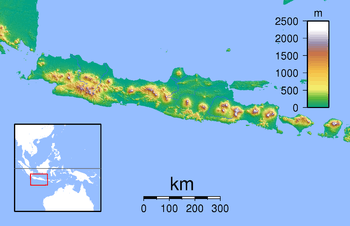Ujung Kulon National Park
| Ujung Kulon National Park | |
|---|---|
| Taman Nasional Ujung Kulon | |
|
IUCN category II (national park) | |
 | |
 Ujung Kulon NP Location in Java | |
| Location | Banten, Java, Indonesia |
| Nearest city | Cilegon |
| Coordinates | 6°44′48″S 105°20′1″E / 6.74667°S 105.33361°ECoordinates: 6°44′48″S 105°20′1″E / 6.74667°S 105.33361°E |
| Area | 122,956 hectares (303,830 acres; 1,229.56 km2) |
| Established | February 26, 1992 |
| Visitors | 2,385 (in 2007[1]) |
| Governing body | Ministry of Environment and Forestry |
| World Heritage Site | 1991 |
| Website | ujungkulon.org |
| Type | Natural |
| Criteria | vii, x |
| Designated | 1991 (15th session) |
| Reference no. | 608 |
| State Party | Indonesia |
| Region | Asia-Pacific |
Ujung Kulon (means : West End) National Park is located at the westernmost tip of Java, within Banten province of Indonesia. It includes the volcanic island group of Krakatoa in Lampung province, and other islands including Panaitan, as well as smaller offshore islets such as Handeuleum and Peucang in the Sunda Strait.
Geography
The park encompasses an area of 1,206 km² (443 km² marine), most of which lies on a peninsula reaching into the Indian Ocean. The explosion of nearby Krakatau in 1883 produced a tsunami (giant wave) that eliminated the villages and crops of the coastal areas on the western peninsula, and covered the entire area in a layer of ash averaging 30 cm thick. This caused the total evacuation of the peninsula by humans, thereby allowing it to become a repository for much of Java’s flora and fauna, and most of the remaining lowland forest on the island.
Ecology

It is Indonesia's first proposed national park and was declared a UNESCO World Heritage Site in 1991 for containing the largest remaining lowland rainforest in Java. After the 1883 eruption of Krakatoa, many settlements in the park were wiped out and never repopulated.[2]
Ujung Kulon stands as the last known refuge for the critically endangered Javan rhinoceros after poachers killed the last remaining rhino in Cát Tiên National Park of Vietnam, where a small population of 10 or less remained back in 2010. In Ujung Kulon the population has been estimated at 40-60 in the 1980s.[3] Within 2001-2010 there have been 14 rhino births identified using camera and video traps.[4] Based on recordings taken between February and October 2011, 35 rhinoceros have been identified, of which 22 were males and 13 females. Of these 7 were old, 18 adults, 5 youngsters, and 5 infant rhinos.[5] Increasing from previous years, in 2013 there were 8 calves which 3 of them were female and 50 teenage and adult which 20 of them were female identifying using 120 video cameras functioning at night with moving sensor. It was accurate data, because every rhino has unique morphology as finger print, mainly skin wrinkles around the eyes.[6]
By 2013 feeding areas of Eupatorium odoratum vegetation have been reduced from 10 locations comprising 158 hectares to just 5 locations comprising 20 hectares. Thus competition for feeding ground between the solitary Rhinoceros and Banteng also increased.[7]
The park also protects 57 rare species of plant. The 35 species of mammal include Banteng, Silvery gibbon, Javan lutung, Crab-eating macaque, Javan leopard, Sumatran dhole, Java mouse-deer and Rusa deer, Smooth-coated Otter. There are also 72 species of reptiles and amphibians, and 240 species of birds.
The status of crocodiles within the park is largely unknown- sightings are rare, but do occasionally occur. There are reports of the false gharial within the park, but these are not confirmed. In addition, the saltwater crocodile was historically present throughout Java's coastal river systems but is currently extinct within these regions. Small, isolated populations of the saltwater crocodile are reported to exist within Ujung Kulon but confirmation is needed.
Conservation
Parts of today's national park and World Heritage site have been protected since the early 20th century. Krakatoa (or rather, the three minor islets which remain of it) was declared as a Nature Reserve in 1921, followed by Pulau Panaitan and Pulau Peucang Nature Reserve in 1937, the Ujung Kulon Nature Reserve in 1958, the Gunung Honje Nature Reserve in 1967, and most recently Ujung Kulon National Park in 1992. In 2005 the park was designated as an ASEAN Heritage Park.[8]
See also
- Andries Hoogerwerf, naturalist active in the conservation of Ujung Kulon in the 1930s-40s.
- National parks of Indonesia
- Protected areas of Indonesia
References
- ↑ Forestry statistics of Indonesia 2007, retrieved 20 May 2010
- ↑ Post, The Jakarta. "Ujung Kulon: Memories of paradise". The Jakarta Post. Retrieved 2016-10-10.
- ↑ van Strien, N.J.; Steinmetz, R.; Manullang, B.; Sectionov, Han; K.H., Isnan; W., Rookmaaker; K., Sumardja; E., Khan; M.K.M. & Ellis, S. (2008). "Rhinoceros sondaicus". IUCN Red List of Threatened Species. Version 2008. International Union for Conservation of Nature. Retrieved 28 November 2008.
- ↑ Antara News: Javan rhinos breed at Ujung Kulon: WWF, 1 March 2011
- ↑ "Populasi Badak Jawa pada 2011 Sedikitnya 35 Individu". December 29, 2011.
- ↑ "Ujung Kulon National Park Says It Gained Seven Javan Rhinos". February 27, 2014.
- ↑ ""Si Cula" Terancam Punah". August 25, 2013.
- ↑ UNEP: Ujung Kulon, retrieved 2010-0108
External links
| Wikimedia Commons has media related to Ujung Kulon National Park. |
- Ujung Kulon National Park at UNESCO World Heritage website.
-
 Ujung Kulon National Park travel guide from Wikivoyage
Ujung Kulon National Park travel guide from Wikivoyage